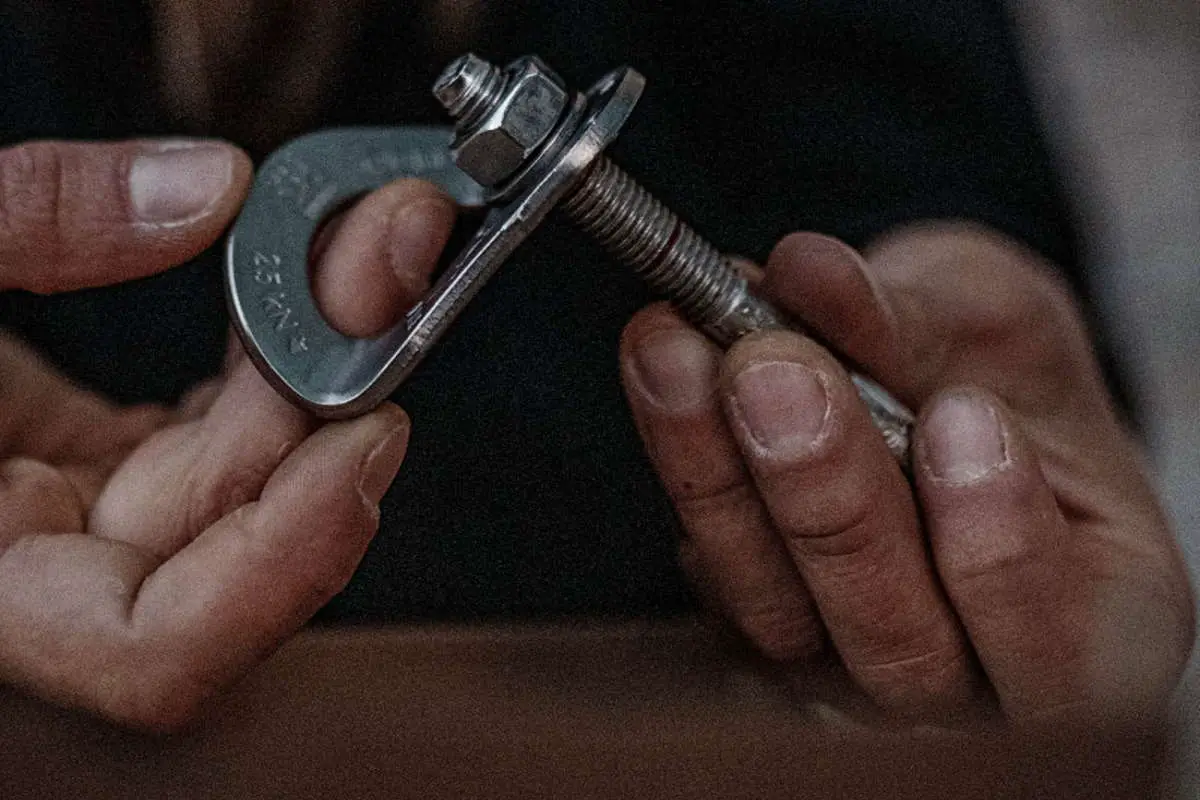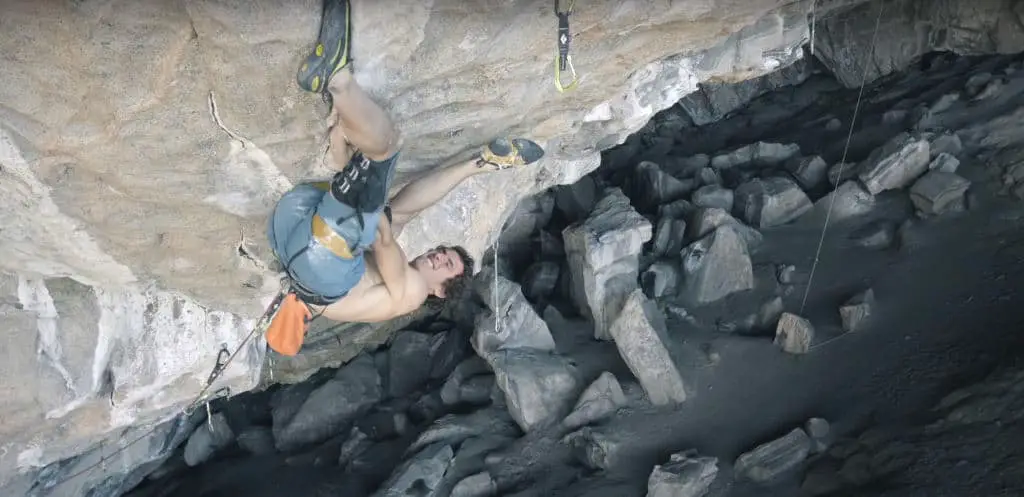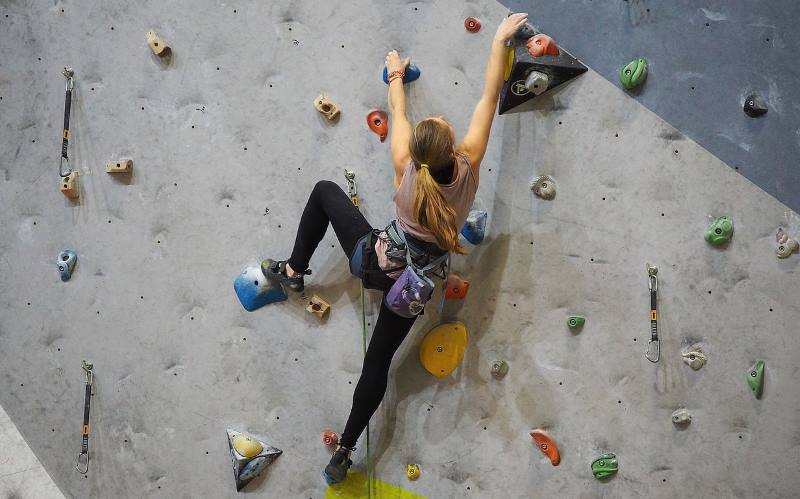If you’ve seen Sport Climbing featured in the Olympics or you’re thinking of trying out climbing yourself – you might wonder what it actually means. Let us introduce you to the sport and explain the jargon.
Sport Climbing made its Olympics debut for the first time recently. Many were wowed by the athleticism and how fearless the lead climbers might seem. Starting outdoors as an evolution from traditional climbing decades ago it is now incredibly popular both indoors and out.
What Is Sport Climbing?
Sport Climbing is climbing using fixed protection for safety. The climber wears a harness and is tied into a rope which is managed by a person below – called the “belayer”. As the climber goes up they clip their rope to bolts fixed into the wall to protect them in the case of a fall.
The belayer has a “belay device” that allows them to give out rope when they need it but hold the rope tight if the climber falls. The climber clips the rope into “quickdraws” which are themselves clipped to bolts with hangers that are drilled into the wall.
The bolts are the key part of sport climbing that differentiates it from traditional climbing. It was once very controversial to drill a bolt into a cliff but is now much more commonplace.
It’s a fairly safe form of climbing that’s all about technique. The aim is to climb from the bottom to the top using your own power only – hands, feet, knees, elbows, and all. Resting with the rope tight or by pulling on any gear fixed into the wall is cheating!

Why Is It Called Sport Climbing?
It’s called sport climbing because it’s seen as a more sporty and physical way of climbing than other types. You can fall safely and once you’ve finished a route you lower down and move on to the next.
Sport climbing is about the physicality and technique of getting up a route and less about the technical side. Typically you can go sport climbing with just a few bits of gear, getting a good amount of different routes done in a day.
Sport climbers might expect to fall quite a lot, practicing specific moves a few times and not worrying about the protection pulling out of the wall. Bolts are meant to take repeated falls and last decades.
In other forms of climbing, you do have protection in the wall to catch you if you fall. However, you generally try not to fall on it as gear as it won’t always hold!

Sport Climbing Terms
- Bolt – The metal rod that is drilled, glued, or uses an expansion bolt to secure into the wall. Most people use the word “bolt” to refer to the whole setup of bolt, hanger, and nut.
- Hanger – The part you actually clip a quickdraw in to. The protruding piece of metal is attached to the wall by the bolt with a nut and washer. Sometimes the hanger is part of the bolt – like with glue-in bolts.
- Carabiner – A metal oval-ish shape that opens with a small gate. Some screw shut. Much stronger than you’d think – Read What Is A Carabiner?
- Quickdraw / Draw – Two carabiners linked by a strong, sewn sling. One carabiner clips to the bolt, allowing the sling to dangle freely, with the rope being clipped into the lower carabiner.
- Anchor – Either bolts or trad gear placed to make a point to either lower or belay from.
- Lower-Off – The place you’ll lower from, essentially the same as an anchor.
- Redpoint / Flash / Onsight – The way you climbed the route – Read more climbing jargon
- Beta – The “moves” or information on how to climb a route – What Is Climbing Beta?
- Clipping – Either clipping a quickdraw into the hanger, or clipping the rope into the quickdraw.
Lead Climbing Vs Top Roping
Lead Climbing means you climb from the ground up clipping into the bolts as you go. You take quickdraws with you, clipping them into bolts and then clipping your rope into the quickdraw.
It’s common to lower from a route, pulling the rope through but leaving the quickdraws in place. You or a partner can then climb and just clip the rope into the draws. You can lead in trad climbing as well but place protective gear instead of clipping into bolts.
Top Roping is when a rope is run through an anchor point or quickdraws above you. Normally someone will lead first and set up a top rope. You can also set up a top rope if you can walk around to the top.
You can do both lead climbing and top roping indoors. Most people learn to top rope indoors and build their skills and confidence, then learn to lead climb, and eventually climb outdoors.
Interested? Read the full guide on How To Start Rock Climbing today!
Is Sport Climbing Dangerous?
Yes and no. While people watching might think that ropes would fail or gear might break – that basically never happens in sport climbing. It’s definitely a physical activity! Scrapes and bruises are common. Falling is always a little scary but you can train yourself to get used to it.
Bigger but less common dangers come from awkward falls, swinging headfirst into the wall, rockfall, or landing badly on a wrist or ankle. Deaths do occur when climbers make mistakes when tying in or rappelling the rope. Wearing a good quality climbing helmet outdoors as well as good partner checking systems can almost eliminate most dangers.
Indoor Vs Outdoor Climbing Differences
In climbing gyms, you’ll find it much easier to get set up and ready to climb. On indoor lead routes, there is a permanent quickdraw attached to each bolt. Routes also have an easy way to lower from the top – generally a pair of burly carabiners.
Top roping routes will have rope already threaded through the top anchors so you can just tie in and climb. Some routes have both top roping and leading. Overhanging routes should be lead climbing only as on top rope a fall can lead to a dangerous swing.
Bolts indoors are often placed about a meter apart so there’s always something close to clip in to. Outdoors bolt placement is harder to do so bolts are generally more spaced out. You could find yourself climbing a couple of meters above a bolt in some areas!

Outdoors you have to place the quickdraws on lead routes, then clip in the rope. Top ropes need to be set up by leading a sport route first and setting up something to thread a rope through. You can also set up a trad anchor to thread the rope through or walk in from the top to set one up.
The big differences are that you’ll have to find the area, figure out which part of the brownish-grey rock is the right route, and deal with any number of potential issues. Getting outdoors and having a mini adventure is half the fun of climbing.
When Did Sport Climbing Start?
Sport climbing really only became its own discipline in the ’70s. Before then many climbs had been bolted either where there were seemingly no other alternatives, or just to get up a wall whatever the means. Bolting and how the bolts were placed has always been controversial – to the point of literal fights.
When routes started getting bolted the ethics were that you had to place the bolts while on the route. As climbers pushed the boundaries of how hard you could climb and how overhung a route could be – this changed.
The first sports climbs – i.e. the first routes meant to be climbed only when protection was already in place – were in the Verdon Gorge in France and the Frankenjura in Germany. Sport climbs are often graded with the French system.
The big change was that climbers would rappel in from the top of the climb, cleaning the rock of vegetation and pulling (or hammering off) loose dangerous sections, and figuring out moves. They could then drill and place bolts in the best places to clip in.
Sport Climbing In The Olympics
For the Tokyo 2020 Olympics, there are actually three different events – Lead Climbing, Bouldering, and Speed Climbing. Most climbers wouldn’t call speed or bouldering “Sport” climbing but for the sake of simplicity, it’s just been called that.
Climbers must place high in all three categories to win. The format is divisive as the three disciplines are very different – especially speed climbing. In the 2024 Paris Olympics, they’ll each have their own medals. Read our full article on Olympics Sport Climbing for everything you need to know.

Lead Climbing is the main activity we do in sport climbing. Climbers must compete to get as high as possible on the same route. The highest hold touched or jumped for is what determines the winner. If there is a tie, time is taken into account
Bouldering is low level climbing up to four and a half meters high. Climbers compete on four different routes that are set on different parts of a wall. The winner is the one with the most tops or “zones” which are basically halfway points on the route. Read What Is Bouldering?
Speed Climbing features two climbers going head to head on the same route side by side. The first to touch the buzzer wins and goes to the next round. False starts or falls are a loss. They use an autobelay system that takes in the slack rope and lowers the climber safely.
Sport Climbing vs Trad + Aid
For Aid or Trad climbing, this means that a single route can take much longer – even a full day. For one route you’ll need a variety of types and sizes of gear. Every time there’s a crack, seam, or hole in the rock you’ll try to place some gear so that it’ll hold.
Placing the gear can take a few minutes plus the longer you are on the wall the more you’ll need to rest. Normally the first climber – the “leader” – will place the gear and the “second” will climb up.
- Aid Climbing is an older but still practiced type of climbing where climbers will wedge or hammer protection into a wall. They use that to pull themselves up, not just their hands and feet – unlike sport climbing.
- Trad Climbing: from traditional. A popular form of climbing where there is no fixed protection in the wall. Climbers use gear like cams and nuts to wedge into the rock for protection – though they still climb using their own strength, unlike aid.
Both sport and trad are forms of free climbing. Free climbing means you climb the rock under your own force with the safety gear just to protect you from falls. Aid climbing uses gear to actually help aid you up.
Learn more – What Is Trad Climbing?
Is Top Roping Sport Climbing?
Yes, top roping is a form of sport climbing. You can top rope indoors and out, on sport or trad. In sport climbing, it’s common to set up a top rope if you’re there more for fun or in order to practice routes.

With trad climbing the second climber will normally be on top rope as they go up to clean the route. Trad climbing routes tend to either have a bolt or two to rappel from or even just a tree or boulder to wrap a rope around.
That being said: if someone says they sport climb they normally mean lead climbing. The mental and psychical aspect of clipping into bolts up the route definitely adds a lot compared to top roping.
Read Is Rock Climbing A Sport?
Is Speed Climbing Sport Climbing?
Not really, it’s basically its own thing separate from what most “climbers” are into. Speed climbing on the same route as in the Olympics format is generally done for competition only and is more popular in Russia and ex-USSR countries.
Speed climbing on single pitch routes isn’t really a thing, though speed records for big multi-pitches are fairly common. In Yosemite, there are many speed records that are battled over – as featured in Reel Rock 14 with Tommy Caldwell and Alex Honnold.
Is Sport Climbing Single Pitch Or Multi-Pitch?
When you think of sport climbing it’s generally single pitch routes. Trying hard and climbing at your absolute peak on sport routes is normally just about those 20-odd meters.
Though most classic multi-pitches are trad there are plenty of multi-pitch bolted sport climbing routes out there. In Europe especially where there are lots of cliffs that suit bolts better than gear, you’ll find some absolute classics.
Can You Sport Climb Alone?
It’s possible to sport climb alone though it’s not very easy or safe. You need to be fairly experienced and have a few key bits of gear plus the knowledge to use them correctly. If you’re just starting this can be incredibly dangerous.
If you’d like to climb alone just take up bouldering. You can boulder indoors and out and, depending on where you live, there might be plenty of choice locally. If you’re concerned about finding a partner there are plenty of ways to find someone cool to learn with.
Read Can You Rock Climb Alone?
How To Start Sport Climbing?
Starting sport climbing nowadays is easier than ever. Wherever you live you’ll likely find a climbing gym that offers taster sessions and lessons. This is by far the best way to start as you’re in a controlled environment with qualified instructors.
You can learn the basics of top roping in just two or three sessions, then come back regularly to hone your skills. After a few months, you might want to try lead climbing and your gym will be able to teach that too.
Getting outdoors for the first time we’d recommend getting a guide or going as a gym outdoors day. You can try it out and see if it’s for you. If it is – great!
What Do You Need To Start Sport Climbing
If you start at a gym you just need comfy clothing. The shoes, harness, and everything else you need to start sport climbing can all be hired. If you’re starting to get into things we’d say a comfy harness and properly fitted shoes should be your first purchases.
Beginner sport climbing gear – Our favorites
– Best Beginner Climbing Shoes
– Best Beginner Climbing Harness
– Best Beginner Climbing Rope
– What To Wear Rock Climbing



